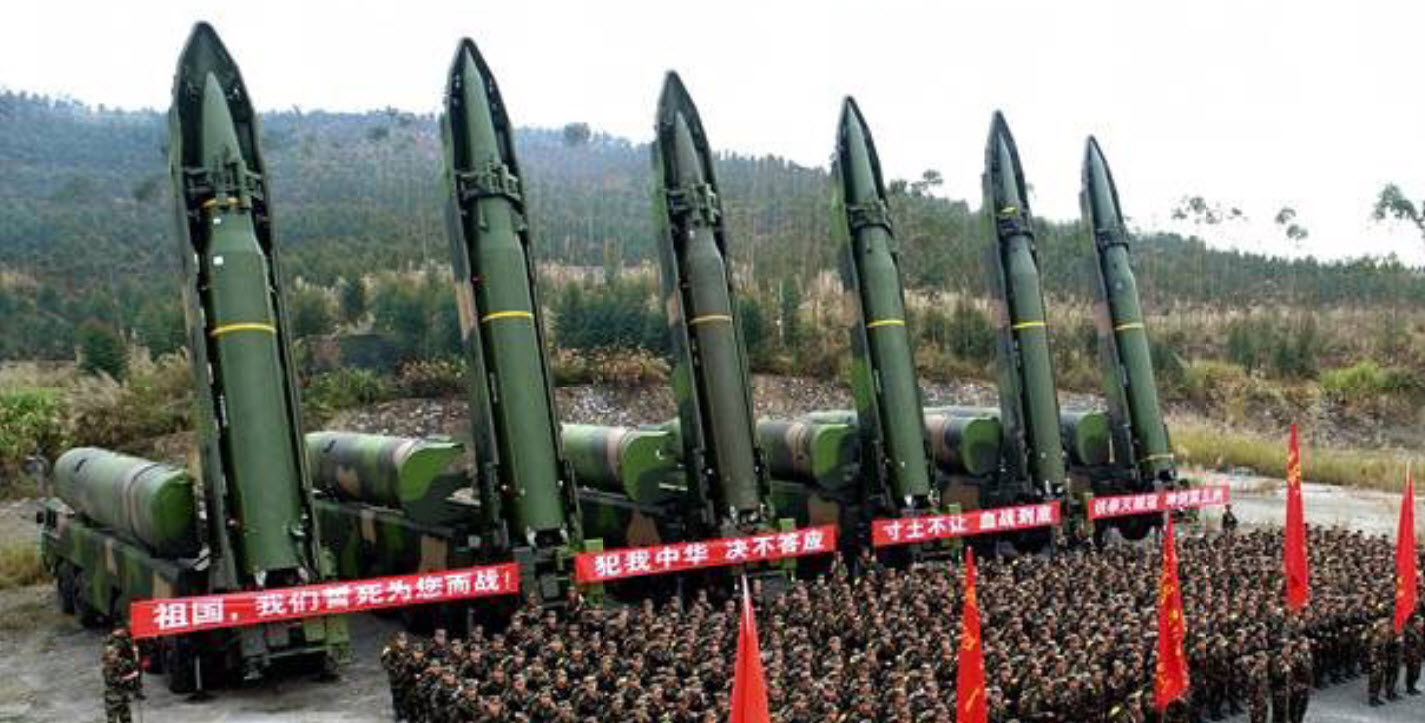Hendrik_2000
Lieutenant General
Interesting speculation from Henri K that the recently retire oiler 904 might become target for ASBM test
Type 904: What if a retired tanker becomes the target of ASBM?
,
BY
This is a page that turns to 884 Jingpohu as a "nanny" of Chinese reef-based garrisons in the South China Sea, but the retirement life for this old Navy Type 904 tanker could be a little out of the ordinary. Indeed, it could suffer the same almost "heroic" fate as the Yuan Wang 4, test and displacement building moving 13,000 tons full load, which was sunk in an anti-ship ballistic missile fire test (ASBM) ) in early November 2011.
If the information seems "attractive" at first glance, caution is still needed and it should be used, at this stage, the conditional because no institutional source has yet mentioned the transfer of the ship to the Force of Chinese rockets.
And yet, the presence of several officers of the latter during the last ceremony of descent of the colors of the Jingpohu , on July 15 in the morning, is a sign that does not deceive. Since the last military reform, the Chinese Rocket Force, one of the five components of the Armed Forces of the People's Republic of China and in charge of the country's nuclear arsenal, as well as all ballistic missiles, including ASBMs specialized in the anti-nvaire attack is an integral part of the Southern Theater Command where the old tanker was assigned, but there is no justification for the participation of these "rocket" officers in the retirement of a ship from their ship. "marine" colleagues, if it is not for a (very) good reason.
That's why the appearance of the Khaki uniform, unique in the Chinese army and which can only represent the Rocket Force, is as interesting as it is surprising
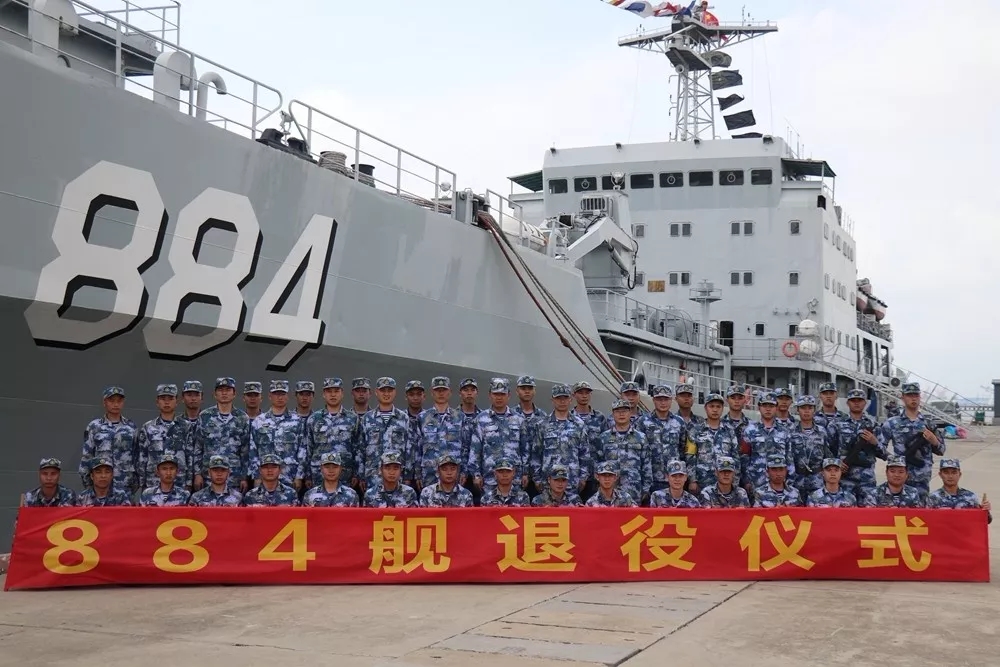
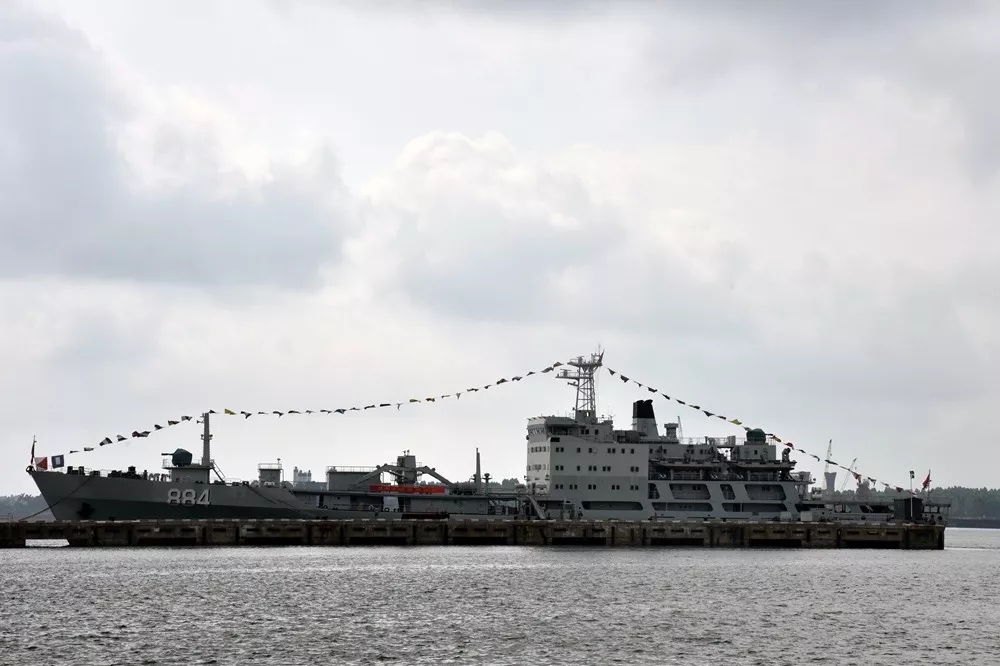
.
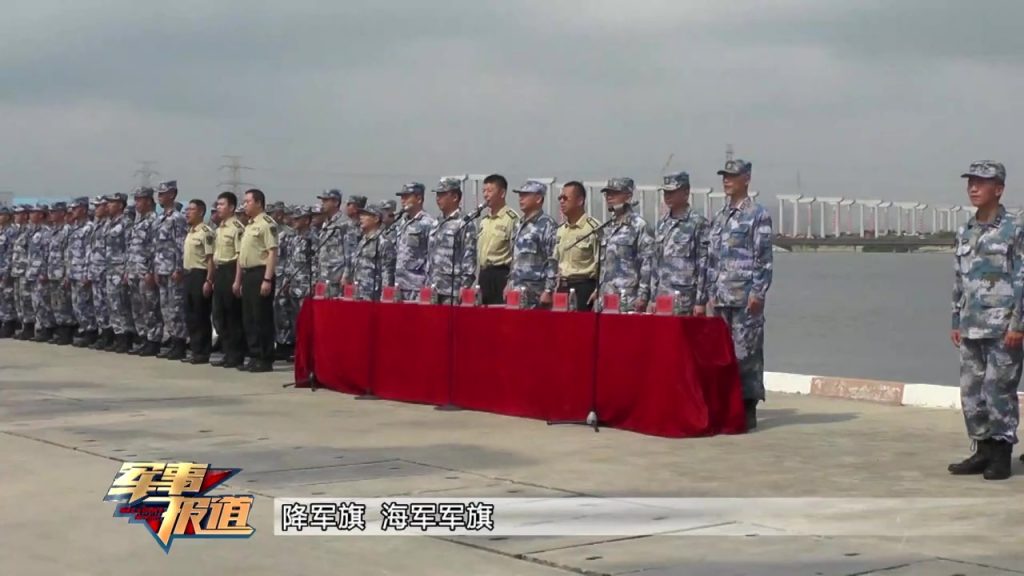
At least 5 officers from the Chinese Rocket Force were present during the disarmament of 884 Jingpohu (Image: CCTV-7
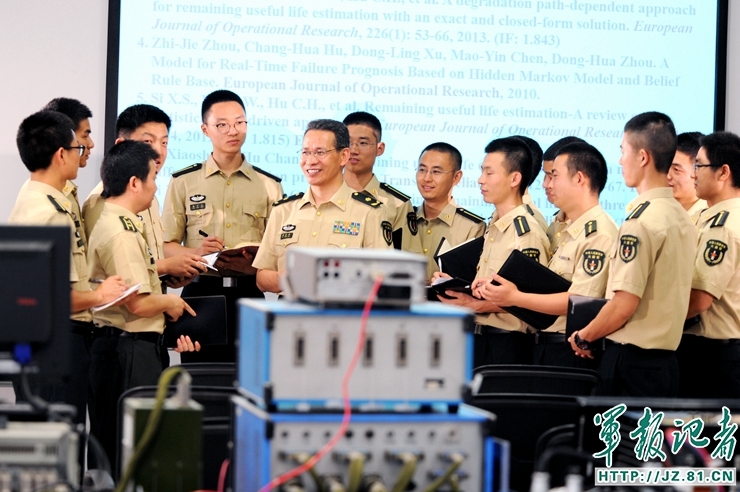
After the victory of the naval battle at the Johnson South reef against the Vietnamese Navy, which took place on March 14, 1988 in the Spratleys, south of the South China Sea, the Chinese army effectively took control of six atolls and reefs in the area. The Type 904 was born with the urgent need to refuel these advanced positions built initially on stilts.
The 884 Jingpohu is the second class whose contract with the shipyard Qui Xin (求新 造船厂) was signed in early 1990. The ship, launched in May 1991 and admitted to active service two years later, was awarded first received the hull number "Southern Transport 952" (南 运 952).
Moving a little over 5,000 fully loaded tonnes, the Type 904 is capable of carrying about 1,400 tonnes of freshwater, freshwater, ammunition and fuel to refuel the reefs in an outing that lasted about two weeks. But if this capacity was considered sufficient enough 20 years ago, the enlargement and fortification of almost all Chinese reefs requires much larger specific supplies. This is how the Type 904A and Type 904B are born in 2007.
Limited by its design and initial architecture, and greatly exceeded by its successors in terms of capacity, this would explain why a ship such as the 884 Jingpohu , still in very good working order, was hastily retired after only 27 years of service.
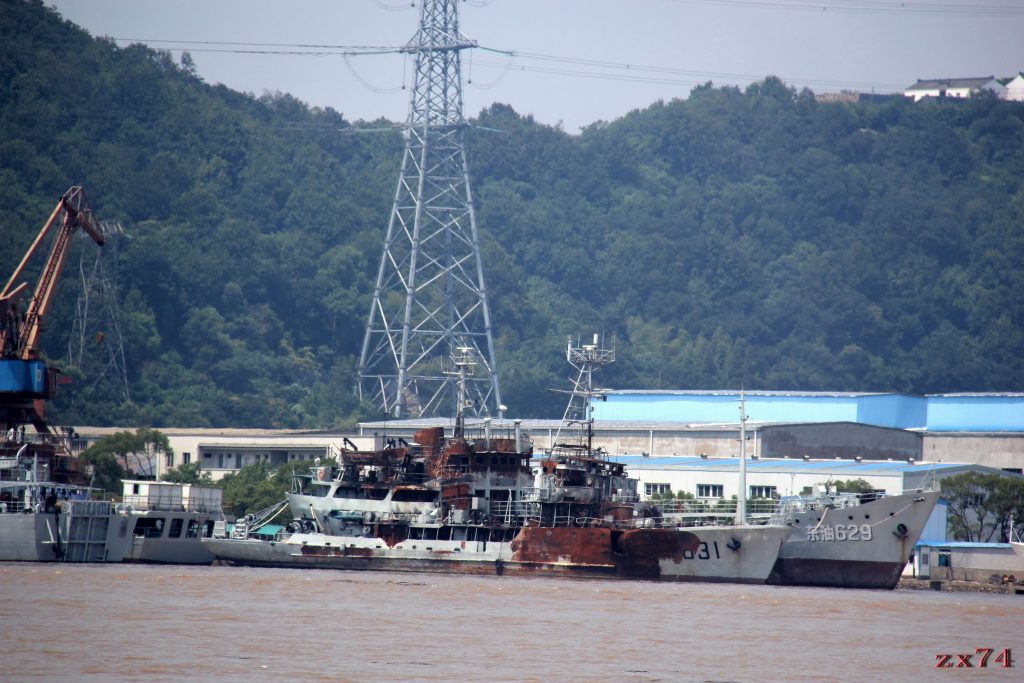
So what do old warships do after disarmament? Apart from the dismantling, the transfer to other para-military components such as the coast guard, the sale to a third country, or the transformation into a floating museum - as is the case for the first nuclear attack submarine Chinese Type 09I which became part of the Marine Museum in Qingdao - converting old buildings into a target ship is also a common practice in China.
But for the Chinese navy, which is still catching up and so the "big" ships of more than 5,000 tons ready to be served as targets are still rare, how to maximize and exploit the remaining value of 884 Jingpohu becomes a real issue .
Given its specificity as a reef feeder, transferring it to the coastguard or selling it to another country seems difficult and inappropriate. The transformation into a museum lacks a land of welcome knowing that the ship is named after a lake and not a city, and the dismantling is an almost luxurious waste. Becoming a target ship seems to be the only way out.
If this conversion into a target ship takes place, it seems natural that the Chinese navy should be the beneficiary of the operation. However, serving as a former tanker as a target for conventional anti-ship missiles, such as the YJ-83, YJ-18 and YJ-12, does not effectively assess the damage of these against the front-line ships of our fleet. days, and most importantly, the Chinese Navy has built enough target ships for its needs.
And it is also too early to look for a mobile target for the new quasi-ballistic hypersonic anti-ship missile that the Chinese navy is currently developing.
While the Chinese navy does not seem to have a need to have a large target ship in the short term, the Rocket Force, for its part, can not say the same thing. After the validation shot of the DF-21D in early November 2011, which hit and sank the Yuan Wang 4 while sailing, several ASBM shots of different models (DF-16x, DF-21D, DF-26C ...) were since then, but there is no indication that sea-going targets have been engaged.
And even for , and which intelligence services have no more revealed if the salvage of six ASBM has targeted real targets in navigation, or simply areas at sea.
Capable of hitting a navigation target that is 156 meters long, 20 meters wide and has several radar reflectors such as Yuan Wang 4, under favorable conditions, has demonstrated and validated the feasibility of the system of systems where the ASBM is only one of the links. But able to hit a target in navigation of 123 × 16 meters, and potentially without a reflector, the technical demonstration will be taken to another level, just like the message sent.
To be continued
Type 904: What if a retired tanker becomes the target of ASBM?
,
BY
This is a page that turns to 884 Jingpohu as a "nanny" of Chinese reef-based garrisons in the South China Sea, but the retirement life for this old Navy Type 904 tanker could be a little out of the ordinary. Indeed, it could suffer the same almost "heroic" fate as the Yuan Wang 4, test and displacement building moving 13,000 tons full load, which was sunk in an anti-ship ballistic missile fire test (ASBM) ) in early November 2011.
If the information seems "attractive" at first glance, caution is still needed and it should be used, at this stage, the conditional because no institutional source has yet mentioned the transfer of the ship to the Force of Chinese rockets.
And yet, the presence of several officers of the latter during the last ceremony of descent of the colors of the Jingpohu , on July 15 in the morning, is a sign that does not deceive. Since the last military reform, the Chinese Rocket Force, one of the five components of the Armed Forces of the People's Republic of China and in charge of the country's nuclear arsenal, as well as all ballistic missiles, including ASBMs specialized in the anti-nvaire attack is an integral part of the Southern Theater Command where the old tanker was assigned, but there is no justification for the participation of these "rocket" officers in the retirement of a ship from their ship. "marine" colleagues, if it is not for a (very) good reason.
That's why the appearance of the Khaki uniform, unique in the Chinese army and which can only represent the Rocket Force, is as interesting as it is surprising


.

At least 5 officers from the Chinese Rocket Force were present during the disarmament of 884 Jingpohu (Image: CCTV-7

After the victory of the naval battle at the Johnson South reef against the Vietnamese Navy, which took place on March 14, 1988 in the Spratleys, south of the South China Sea, the Chinese army effectively took control of six atolls and reefs in the area. The Type 904 was born with the urgent need to refuel these advanced positions built initially on stilts.
The 884 Jingpohu is the second class whose contract with the shipyard Qui Xin (求新 造船厂) was signed in early 1990. The ship, launched in May 1991 and admitted to active service two years later, was awarded first received the hull number "Southern Transport 952" (南 运 952).
Moving a little over 5,000 fully loaded tonnes, the Type 904 is capable of carrying about 1,400 tonnes of freshwater, freshwater, ammunition and fuel to refuel the reefs in an outing that lasted about two weeks. But if this capacity was considered sufficient enough 20 years ago, the enlargement and fortification of almost all Chinese reefs requires much larger specific supplies. This is how the Type 904A and Type 904B are born in 2007.
Limited by its design and initial architecture, and greatly exceeded by its successors in terms of capacity, this would explain why a ship such as the 884 Jingpohu , still in very good working order, was hastily retired after only 27 years of service.

So what do old warships do after disarmament? Apart from the dismantling, the transfer to other para-military components such as the coast guard, the sale to a third country, or the transformation into a floating museum - as is the case for the first nuclear attack submarine Chinese Type 09I which became part of the Marine Museum in Qingdao - converting old buildings into a target ship is also a common practice in China.
But for the Chinese navy, which is still catching up and so the "big" ships of more than 5,000 tons ready to be served as targets are still rare, how to maximize and exploit the remaining value of 884 Jingpohu becomes a real issue .
Given its specificity as a reef feeder, transferring it to the coastguard or selling it to another country seems difficult and inappropriate. The transformation into a museum lacks a land of welcome knowing that the ship is named after a lake and not a city, and the dismantling is an almost luxurious waste. Becoming a target ship seems to be the only way out.
If this conversion into a target ship takes place, it seems natural that the Chinese navy should be the beneficiary of the operation. However, serving as a former tanker as a target for conventional anti-ship missiles, such as the YJ-83, YJ-18 and YJ-12, does not effectively assess the damage of these against the front-line ships of our fleet. days, and most importantly, the Chinese Navy has built enough target ships for its needs.
And it is also too early to look for a mobile target for the new quasi-ballistic hypersonic anti-ship missile that the Chinese navy is currently developing.
While the Chinese navy does not seem to have a need to have a large target ship in the short term, the Rocket Force, for its part, can not say the same thing. After the validation shot of the DF-21D in early November 2011, which hit and sank the Yuan Wang 4 while sailing, several ASBM shots of different models (DF-16x, DF-21D, DF-26C ...) were since then, but there is no indication that sea-going targets have been engaged.
And even for , and which intelligence services have no more revealed if the salvage of six ASBM has targeted real targets in navigation, or simply areas at sea.
Capable of hitting a navigation target that is 156 meters long, 20 meters wide and has several radar reflectors such as Yuan Wang 4, under favorable conditions, has demonstrated and validated the feasibility of the system of systems where the ASBM is only one of the links. But able to hit a target in navigation of 123 × 16 meters, and potentially without a reflector, the technical demonstration will be taken to another level, just like the message sent.
To be continued

